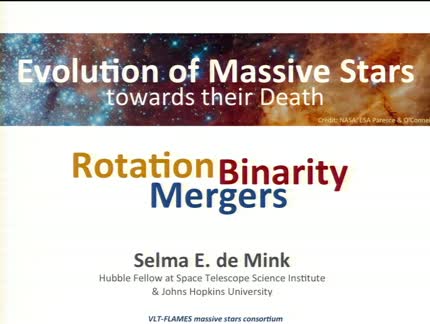Found 6 talks width keyword stellar rotation

Abstract
Exciting things may have happened sometimes to the stars we see in the sky today. For example, Betelgeuse, also known as Alpha-Ori, an M-type red supergiant, the 10th brightest sky in the sky (usually), may well have been a binary star in the past. Its rapid rotation, peculiarly large Galactic velocity, and unusual chemical abundances all point to it being kicked out from the birth environment and merging as a binary star. By comparing a Monte-Carlo stellar cluster population model with the observed populations of Galactic O- and B- type stars (progenitors of red supergiants), I will show that the story of Betelgeuse is not at all uncommon. In distant galaxies, closely related scenarios may give rise to peculiar core-collapse supernovae. I will conclude by briefly discussing how the diversity of such binary and triple stellar evolution histories reflects in the variety of the currently discovered core-collapse supernovae.

Abstract
Rotation plays an important role in the life of stars and offers a potential diagnostic to infer their ages and that of their planets. This idea is known as gyrochronology, and if properly calibrated, its applications to Galactic, stellar, and exoplanetary astrophysics would be far-reaching. Nevertheless, while potentially fruitful over a wide range of ages and masses, recent results have raised concerns regarding gyrochronology’s applicability. In this talk, I will present the opportunities that the Gaia astrometry has opened to address these issues. First, regarding rotation’s classical calibrators, I will illustrate the impact that removing the non-member contamination has on the rotational sequences of open clusters. Second, I will present a novel method that tests the state-of-the-art gyrochronology relations in under-explore domains using wide binary stars. Finally, I will discuss the prospects for expanding the existing rotational constraints in unprecedented regimes using data from the TESS mission.

Abstract
The new generation of spectrometers designed for extreme precision radial velocities enable correspondingly precise stellar spectroscopy. It is now fruitful to theoretically explore what the information content would be if stellar spectra could be studied with spectral resolutions of a million or more, and to deduce what signatures remain at lower resolutions. Hydrodynamic models of stellar photospheres predict how line profiles shapes, asymmetries, and convective wavelength shifts vary from disk center to limb. Corresponding high-resolution spectroscopy across spatially resolved stellar disks is now practical using differential observations during exoplanet transits, thus enabling the testing of such models. A most demanding task is to understand and to model spectral microvariability toward the radial-velocity detection of also low-mass planets in Earth-like orbits around solar-type stars. Observations of the Sun-as-a-star with extreme precision spectrometers now permit searches for spectral-line modulations on the level of a part in a thousand or less, feasible to test against hydrodynamic models of various solar features.

Abstract
We will start by recalling the effects of rotation on stellar evolution and briefly explain its implementation in a stellar evolution code. We will present a set of various grids of massive stars models, and then show some recent results obtained by our new SYCLIST toolbox, which is able (among other things) to generate synthetic stellar clusters, including various physical ingredients, such as initial rotation and angle of view distributions, gravity and limb darkening, etc.

Abstract
The application of the Fourier transform (FT) technique to high resolution spectra of OB-type stars has challenged our previous knowledge about stellar rotation in stars in the upper region of the HRD. The FT is an old and powerful tool that has being widely used in the case of cool stars, but only very recently applied to massive stars in a systematic way. In this talk I will present the results of the line-broadening characterization of ~250 Galactic OB-type stars (including dwarfs, giants and supergiants with spectral types O4-B9) from the IACOB spectroscopic database. I will show how these analyses have led to a downward revision of previously determined projected rotational velocities in these stars, and have definitely confirmed the presence of a non-negligible extra line-broadening contribution (commonly called macroturbulent broadening) in the whole OB star domain. I will also provide some notes about the importance of these findings on the evolution of massive stars and the detection of stellar oscillations along the lifetime of these important astrophysical objects.

Abstract
« Newer Older »
Upcoming talks
- Classical Be stars - Constraining binary interaction physics in massive starsDr. Julia BodensteinerThursday April 25, 2024 - 10:30 GMT+1 (Aula)
- Runaway O and Be stars found using Gaia DR3, new stellar bow shocks and search for binariesMar Carretero CastrilloTuesday April 30, 2024 - 12:30 GMT+1 (Aula)









